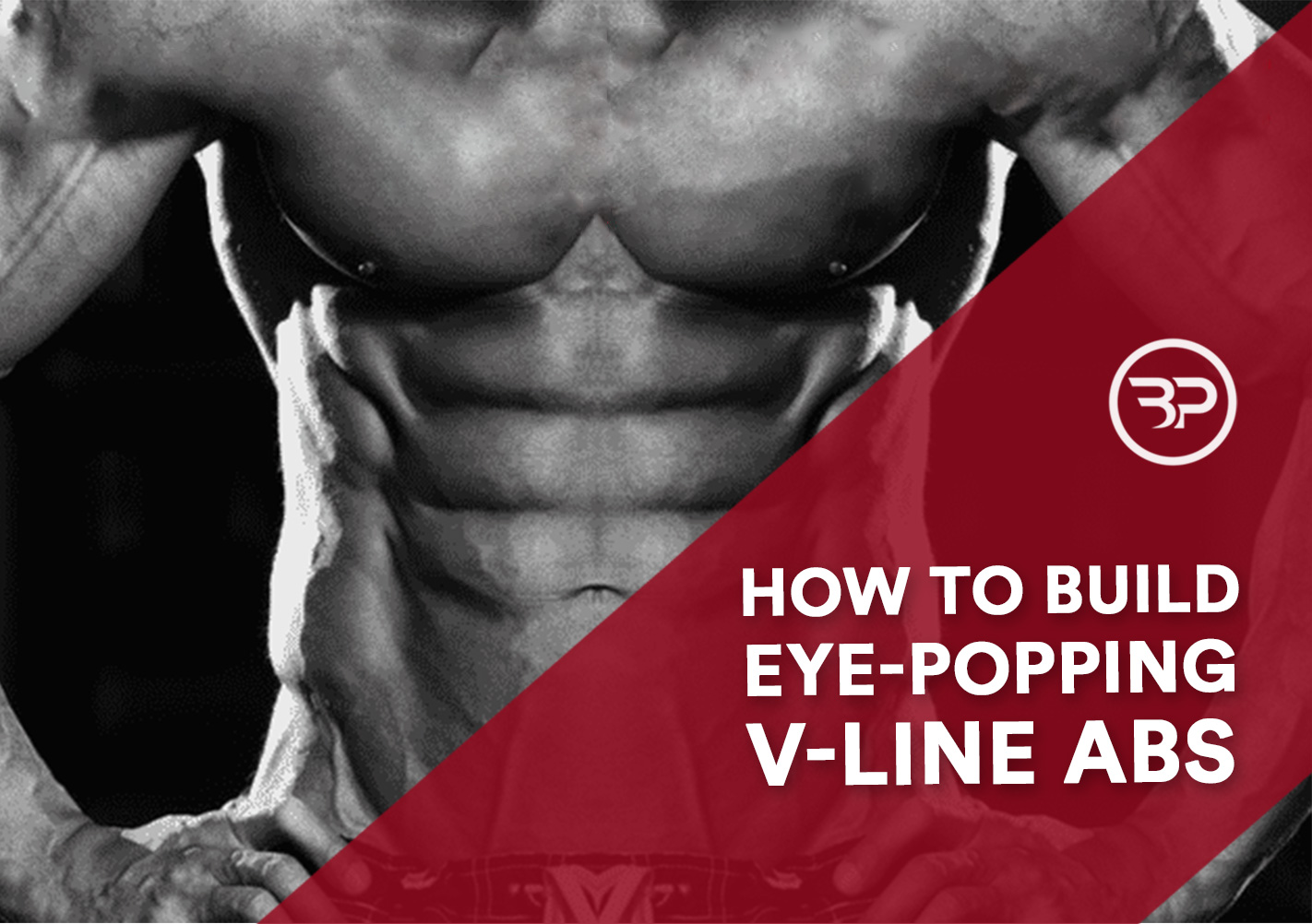V-Line Abs: How to Build Shredded 6-Pack Abs
January 31, 2018
“Bro. I don’t care about getting stronger. That’s been easy for me. I just want to see my abs for the first time. And I’m not just talking the first two abs, I want v-line abs, ya know…those sex lines.”
Sound familiar?
Well, it does to me. Sort of.
There are many lifters who are plenty strong. There are many athletes who are great at what they do. But a good number of them still struggling with one elusive aesthetic goal:
Building six-pack, v-line abs.
We’re talking about deep cut v-line abs that’ll make Derek Zoolander jealous.
What Are V-Line Abs Called?
Unless you’re a skinny dude with the metabolism of a hummingbird on meth, deep-cut six-pack abs are visual proof of your discipline in the kitchen.
They also say something about your training focus.
Still, there are abs…and then there are v-line abs.
V-line abs, when you’re lean enough to show your inguinal ligament, are called anything from “sex lines” to moneymakers.
The v-line comes from the two inguinal ligaments that originate in your hips and extend to your pubic bone.
The V-lines are not a muscle and therefore cannot be directly trained.
Can everyone get v-cut abs? The Crucial Steps
How can you make your sex lines/v-line abs visible?
First, seriously commit to getting extremely lean. We’re talking in the neighborhood of 5-8% body fat or so.
Yes, you read that right.
Second, develop muscular abs.
Though the actual “v-lines” are a ligament, it does help to have deep, muscular abs. The more muscle you have, the more definition you’ll reveal once you reduce body fat.
Get Lean First
If I hear the phrase “abs are made in the kitchen” one more time, I might just gag on my protein shake.
The problem is, the phrase is 100% true.
Chances are you won’t be able to out-train a bad diet and get shredded enough to reveal v-line abs unless you’re blessed with great genetics.
Alas, most of us aren’t.
So you must diet my friend. Fat loss still comes down to energy balance. You must take in fewer calories than you burn each day to lose fat.
Related: How to Calculate Your Calories For Fat Loss
The extreme leanness needed for v-line abs often requires a customized approach.
Maintaining v-line abs is not possible all the time for most people. It’s more realistic to shoot for v-line abs only occasionally.
My online training client, Naz, is an example. He built v-line abs for a recent photo shoot, then went back to something more sustainable.
Ideally, I’d advise getting professional help. And guess what?
I’m available. (A shameless plug, I know, but hey: I have a mortgage to pay, a kid, and dog food bills that are spiraling are out of control.)
But if you want to go it alone, the remainder of this blog post will explain how in five steps.
Beware steps one and two may make your head spin. Unless you have an affinity for math, Consider skipping directly to Step 3.
How do you get v line abs?
Step One: Determine Your Own Body Fat and Lean Body Mass
Before determining a plan of action, you must determine where you currently are. Here is a visual display of body fat by percentage.
BIA
BIA, known as bioelectrical impedance analysis, is a common body fat measurement tool. It often comes in the form of a handheld device or digital scale.
BIA is notoriously sporadic and works by measuring electrical signals through your body. Hydration status and timing play a major role. These are highly variable, so you must be consistent with your timing of measurement as well as hydration. BIA analyzers are often quick and easy, but the numbers can be off by 5% or more.
Skinfold
Skinfolds, when done with a skilled professional, can be as close as +/- 2-5%. Skinfolds measure your levels of subcutaneous fat; the fat directly beneath your skin. These are a great option because taking a skinfold is cheap and easy to learn.
DEXA is best
Dexa scans, which normally cost anywhere from $25-$100, are the most accurate test and are generally spot-on for measurements. If you want the best measurement possible, get a DEXA scan.
Whatever option you choose to analyze body-fat, stay consistent. Different tools will likely yield different results.
Step Two: Calculate How Much Fat You Need to Lose and How Long It Will Take
Research has shown the maximum rate of fat loss to be about 1-2% of your body weight per week. There are times when you may lose more than this due to water weight and – ahem – bodily functions. But 1-2% is a good, consistent mark to shoot for.
Let’s say you were 200 pounds at 16% body fat.
First, we’ll calculate your lean body mass.
200lbs x .84 (% of lean mass) = 168 pounds. You have 168 pounds of lean body mass (bone, water, muscle etc.).
If you need to be 5% body fat without losing any muscle, you would do this simple calculation.
168 x1.05= 176 pounds.
Therefore, your goal would be to diet to 176 pounds or so.
Above, we talked about 1-2% is the maximum rate of fat loss. So at 200 pounds, at 16% body fat, you can expect to lose 2-4 pounds per week at first; provided your diet and training are dialed in.
Fat loss will slow drastically the leaner you get. But for now, let’s “pretend” you maintain this amount of fat loss each week. You would need to calculate at the new bodyweight to be precise, but if you maintain 2-4 pounds of fat loss per week….
… it would take you anywhere from 6-12 weeks of hard dieting to reach 5% body fat and have deep, v-cut abs.
Step Three: Calculate Your Calories
Research indicates a 20-25% caloric deficit is about as aggressive as you can go for moderate time periods without losing significant amounts of lean muscle mass and over-stressing your body.
First, determine your maintenance calories.
Then, we’ll find how many calories you need to create a deficit and carve away belly fat.
For maintenance, we’ll use body weight (pounds) x 14.
An active, 200-pound man (we’ll call him Gerard Butler) is 16% body fat and in shape but has no visible abs.
He would need 200 lbs x 14 = 2,800 calories.
To create a 20-25% deficit we’ll take…
2,800 calories x.8= 2,240 calories per day.
2,800 calories x.75= 2,100 calories per day.
One caveat: If you’ve been dieting long-term, then this may be way off. Your metabolism can adapt to long periods of dieting, resulting in a metabolic slowdown. This stuff can get complicated when we’re talking about extreme leanness.
Step Four: Nail Your Macros
While calories are the most important component, the macronutrient split (how many grams of protein, fat, and carbohydrates) also counts.
Some folks do better with higher carbs and low-fat, whereas others thrive with low-carb and high-fat diets. This is extremely variable from person to person.
Protein For Fat Loss
During a fat loss diet eating a high-protein diet is essential to maintain lean muscle mass. This helps you maintain a sound metabolism and of course, helps you look “more jacked’ once you strip the fat off.
At a minimum, I recommend 1g of protein per pound of body weight during fat loss phases.
Occasionally, I’ll recommend 1.2g/lb of bodyweight. Research shows 1g/lb to be the “maximum” benefit.
But ff there’s one macronutrient you’re going to overconsume during an aggressive diet, best that it’s protein. Nearly 30% of the calories in protein are burned during the breakdown of protein into useable amino acids.
Carbs
As a general rule, 1g of carbs per pound of body weight is a safe bet.
This is low enough. Unless you have significant fat to lose, or true blood sugar control problems, there is nothing wrong with a higher carbohydrate approach to lose fat.
As long as your calories are low, some level of carb intake improves workout performance and can keep your energy levels balanced throughout the day.
Later in the diet, you can cut carbs in final prep mode. But again, this is an advanced strategy that requires customization in most cases.
Fat
The remainder of your calories will come from fat. You’ll need enough fat to maintain anabolic hormone levels, but not too many where you blow your calories out of the water.
Here is how to break it down. We’ll run with
- Calories: 2,100 per day.
- Protein= 4 calories/gram — 200 g protein (1g/lb) x 4= 800 calories
- Carbs= 4 calories/gram =200 lbs (1g/lb) = 200g/carbs x 4= 800 calories
2,100 calories -800 (from protein) – 800 (from carbs) = 500 calories remain.
- Fats= 9 calories/gram = 500 calories/9 calories/gram = 45 calories/gram.
Altogether, a 200 pound Gerard Butler would aim for:
- 2100 calories
- 200 grams of carbs
- 200 grams of protein
- 45 grams of fat
Track your calories with an app like MyFitnessPal. Yes, I know counting calories can be a pain in the ass, but I’ve never met anyone who’s gotten shredded without tracking his or her food. Either do the work that is required and get results or don’t and wonder why you’re not progressing. Your goal.
V-Line Six PackAbs: The Bottom Line
Calories are king when it comes to fat loss, but macros are also important.
Take care of calories first, protein second, then test different amounts of carbohydrates versus fats. As long as your calories are on target, eat carbs and fats as it fits your preferred eating style.
Step Five (Optional): Supplementation
In most cases, I’m not a fan of supplements for fat loss. But once you’ve dialed in your diet and are training hard, a few supplements can accelerate fat loss. This is especially true for elite levels of leanness.
Green Tea Extract
The fat loss benefits of Green Tea are dose-dependent. According to Examine, the maximum fat loss benefits are achieved at high doses, such as 400-500 mg per day.
Yohimbine
Yohimbine can accelerate fat loss and aid in erectile dysfunction, but it’s not for everyone; particularly high-stress individuals and those with anxiety. Examine has found yohimbine to burn fat best on an empty stomach and be dose-specific at /2 mg/kg body weight.
This results in a dosage of:
- 14 mg for a 150lb person
- 18 mg for a 200lb person
- 22 mg for a 250lb person
Pre Workout: Coffee or Onnit T+
When you’re dieting, hard training will occasionally be the last thing you’ll want to do. In this case, extra caffeine and/or pre-workout supplements will help.
If you’re looking for additional fat burning, caffeine – and coffee in particular – is a useful tool.
Reduce Stress and Get More Sleep For Six Pack Abs
Cortisol, the stress hormone, can wreak havoc on your fat loss diet. Being that you’re already stressed and fat loss diets add an extra stressor, you must also manage stress to build your best-looking body.
First, get more sleep. Your body needs rest, especially if you want to build muscle and stay lean. If you’re not getting six to eight hours of quality sleep per night, kiss your dreams of having sculpted abs goodbye.
In one study published in Growth Hormone & IGF Research, researchers pointed to the fact men have one single burst of growth hormone released each day. And it happens during their sleep.
Guys who sleep less and spend less time in slow-wave sleep tend to notice a decline in the amount of growth hormone released.
Growth hormone is a powerful anti-aging hormone as well as a fat burner. Suboptimal levels of growth hormone can hinder fat loss.
Sleep deprivation correlates with higher cortisol and lower testosterone levels. It hinders workout quality, decreases muscle building, and increases fat storage. Yikes.
Second, start meditating. Meditation improves focus and productivity. It has a positive impact on nearly all areas of your health and decreases stress.
Don’t be fooled by pictures of monks meditating in a peaceful garden; you don’t need to spend all day in a zen state. I recommend using the Headspace app and starting with 10 minutes per day at the same time every day.
Adopting the simple habits of meditating and getting adequate sleep accelerates fat loss by improving hormone levels and reducing stress.
Training For V-Line Abs
Your workouts must include compound lifts like deadlifts, squats, pull-ups, and lunges as the foundation of your training.
Lift three to four days per week and do some form of conditioning at least once or twice per week.
Training for strength with big movements works your abs, stimulates the release of anabolic hormones like testosterone and growth hormone, and does more for building a beach-ready physique than any single ab routine.
If you’re looking for a dedicated program to get you in tip-top shape without living in the gym, I’d recommend you check out this abs workout.
Still, training your abs is vital to revealing chiseled abs and that coveted V-cut. Stronger and muscular abs create deeper separations and cuts between the rectus abdominis muscle, helping your abs remain visible even when your body fat is a bit higher.
The V-Line Abs Workout
Perform this workout separate from your other weight training two times per week. If you need more than four weeks to get in tip-top shape (and you probably will) perform this routine twice a week for one month.
Then, take one month completely off before returning for a second round as you wrap up your cut. This keeps the training stimulus novel; promoting gains. The planned break allows full recovery to maximize your hard work.
1. Hollow Body Hold — 3x 45-60 seconds, rest 45-60 seconds
A gymnastics move by nature, the hollow body hold teaches you to brace and hold a neutral spine while contracting your entire rectus abdominis muscle.
Lay flat on the ground, looking up. Flatten your lower back and flex your knees, pointing your toes away from you. Extend your legs in front of you while picking up your arms, keeping your back flat, and lifting your head and shoulders off the ground. Aim to do these twice a week.
https://youtu.be/QMn-6_06MmU
2. Ab Wheel – 3 x 6-10, rest 60-90 seconds
Ab wheel rollouts are an absolute killer for ab development. Plus, they force you to resist the extension (arching) of your lower back while also training your lats, shoulders, and triceps.
Kneel down, holding the handles of the wheel with your arms locked out beneath your shoulders. Brace your abs and roll out as far as possible, then roll back without shifting your hips or arching your lower back. Alternatively, the stability ball rollout is a great drill to progress towards the ab wheel.
Start small: The ab wheel brings intense muscular damage and soreness.
Start with two to three sets of six to eight reps twice per week. Add two reps per week (up to 15 or so), and then move on to adding a third set.
3. Farmer’s Walk — 3 x 60 seconds, rest 60 seconds
Dubbed the “most functional exercise” by experts like Gray Cook and Stuart McGill, farmer’s walks should be in every training program.
Walking with heavy dumbbells in hand, your core is forced to dynamically stabilize the hip and midsection during every step, which fires up your abs and teaches deep stabilizing muscles to stay strong and hold position during other exercises.
Grab a pair of heavy dumbbells and walk slowly — heel to toe — for 30 to 60 seconds, squeezing the dumbbells and staying as tall as possible throughout the entire set. Perform 3 sets of 30 to 60-second walks twice per week.
If you want to spice up your weighted carries, see these variations.
4. Hanging Leg Raise 3×10-15, rest 60 seconds
The hanging leg raise is a popular exercise for targeting the part of your abs below your belly button. By keeping your elbows slightly bent and shoulders retracted, you’ll also stretch the lats, build a stronger grip, and develop more muscular forearms.
As with the other ab exercises in this list, keep your abs braced, and avoid arching your lower back. Grab a pull-up bar with a double overhand grip, squeezing the bar as tight as possible, and keeping the elbows slightly bent.
Retract your shoulders, as if tucking them into your back pocket and holding them there.
This protects the ligaments and tendons in your elbows and shoulders from unnecessary stress. From this position, flex your quads and bring your legs up just past 90 degrees, allowing your hips to roll up, forming an L shape with your body. Pause at the top for two seconds, then lower with control.
Too Tough? Start by bending your knees and holding them up at 90 degrees for 5-10 seconds for each rep. Perform 3-4 sets of 10-15 reps twice per week
A Proven Plan for V lines
With a strategic plan of action, determination, and plenty of willpower, you can get the vaunted V-line abs that will make your physique stand out.
But you must commit to eating right, training right, and recovering right.
Here’s how:
- Dedicate yourself to a diet that puts you in a caloric deficit.
- Continue training with big, multi-joint lifts three to four times per week while doing a conditioning drill once or twice.
- Refine your training and attack your abs twice per week with the exercises above.
- Finally, sleep well and reduce stress. These are the secret weapons and the most commonly neglected aspects of transforming your body.
With discipline, perseverance, and dedication, you’ll achieve the epitome of a lean beach body: deep-cut abs and defined V lines.
And if you’re looking for the perfect workouts and diets to get you there, start here: Bachperformance.com/coaching











[…] Source link […]
Skinny dude with a metabolism of a hummingbird on meth? Oh you’re talking about me. Hi.
Haha, me too.
[…] those cover models with defined, V-cut abs? I outline the whole process here but they’re closer to 5% body fat for men and 14% for women. The lower your body fat gets, the […]
[…] hopped on the low-carb bandwagon at some point. These diets work well for fat loss, but not building […]